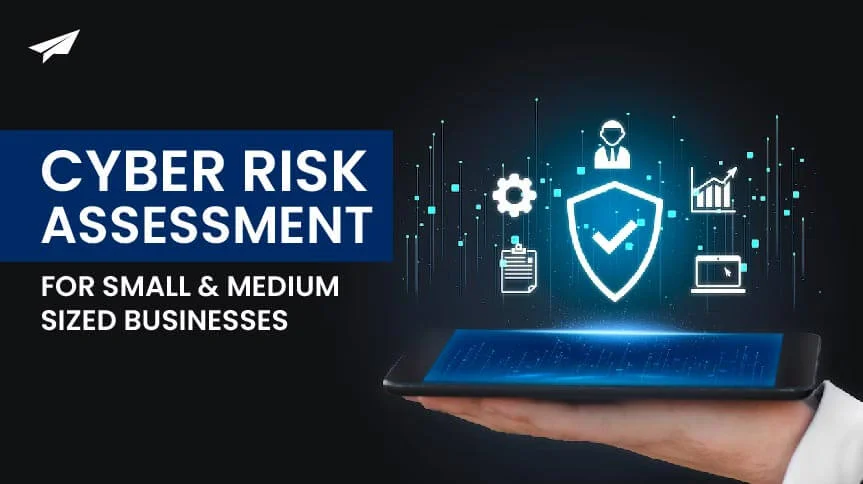Cyber Risk Assessment for Small & Medium-Sized Businesses
SMB businesses must conduct comprehensive cyber risk assessments to protect themselves from these threats, as in today’s interconnected world, small and medium-sized businesses (SMBs) face increasing cyber threats that can severely affect their operations, reputation, and bottom line. During a risk assessment, small and medium-sized businesses (SMBs) must prioritize risks based on their potential impact and likelihood of occurrence. This enables companies to allocate resources effectively and focus on mitigating the most critical threats. In this blog post, we will explore the importance of cyber risk assessment for SMB business and delve into critical aspects such as risk prioritization, security risk assessment, types of risk, managing cyber risk, security posture, and ensuring the security of critical assets.

Understanding Cyber Risk Assessment:
Cyber risk assessment involves identifying, analyzing, and evaluating potential risks compromising an organization’s digital assets’ confidentiality, integrity, and availability. It provides a systematic approach to assess vulnerabilities, threats, and their potential impact on business operations. By conducting a cyber risk assessment, SMB business gains valuable insights into their risk landscape, enabling them to develop effective risk management strategies.
The security posture of a small and medium-sized business (SMB) refers to its overall security strength and resilience against potential threats. It encompasses the organization’s security policies, procedures, controls, and the effectiveness of its security measures. Understanding and maintaining a strong security posture is crucial for safeguarding digital assets and protecting the business from cyber threats.
Risk Prioritization is a crucial step in risk assessment. SMBs must identify and prioritize risks based on their potential impact and likelihood of occurrence. This process helps businesses allocate resources efficiently and prioritize mitigating the most critical threats. Factors such as financial impact, regulatory compliance, and the value of digital assets should be considered for risk prioritization.
Benefits of Security Risk Assessment
Conducting a security risk assessment can be a game-changer for small and medium-sized businesses (SMBs). This evaluation provides an in-depth understanding of an organization’s security posture, potential threats, and vulnerabilities, which can help identify areas for improvement.
By pinpointing weaknesses in an organization’s systems, processes, and infrastructure, targeted security measures can be implemented to reduce the risk of exploitation. By having a clear understanding of the potential impact and likelihood of various risks, businesses can prioritize critical vulnerabilities and take appropriate action.
Through a security risk assessment, SMB business can develop effective mitigation strategies by identifying and assessing potential threats. This proactive approach enables businesses to address vulnerabilities before they can be exploited, thereby significantly reducing the likelihood and severity of security breaches. Additionally, conducting a security risk assessment helps SMBs ensure compliance with applicable regulations on data protection, privacy, and security, which are industry-specific.
Types of Risk
Cyber risk encompasses various threats that SMB business needs to be aware of. These include:
a. External Threats: These are risks posed by external factors such as hackers, cybercriminals, and malicious software. They may attempt to gain unauthorized access to sensitive data, disrupt business operations, or exploit vulnerabilities.
b. Internal Threats: Internal risks arise from employees, contractors, or partners authorized to access the organization’s systems. These risks may include accidental data breaches, misuse of privileges, or negligent behavior.
c. Operational Risks: Operational risks stem from weaknesses or failures in an organization’s processes, systems, or infrastructure. These risks may result from inadequate security controls, poor change management practices, or system vulnerabilities.
By understanding these different types of risks, SMBs can tailor their risk management strategies to address specific vulnerabilities and prioritize mitigation efforts. Implementing appropriate security controls, conducting regular employee training, and staying updated with industry best practices can help mitigate these with cyber risk assessment and safeguard the organization’s digital assets.
Manage Cyber Risk
Manage cyber risk involves implementing appropriate measures to mitigate identified risks. SMBs should develop and enforce security policies that define acceptable use of technology, password requirements, data handling procedures, and incident response protocols.
Training for employees on cyber risk assessment and penetration testing is essential to reduce human error and strengthen the organization’s security posture. Employees should be educated about phishing attacks, social engineering techniques, and the importance of strong passwords. Keeping software and website systems up to date is crucial for addressing vulnerabilities and reducing the risk of exploitation by cyber threats. Regularly applying security patches and updates help protect against known vulnerabilities. MFA improves security by requiring multiple forms of identification, like a password and a unique code sent to a mobile device. This results in a significant reduction in the possibility of unauthorized access.
SMBs should establish a monitoring system to promptly detect and respond to security incidents. This includes implementing intrusion detection systems, log monitoring, and incident response plans.
Ensuring Assets Security
Digital assets security is paramount for SMB business. This includes:
a. Data Encryption: Encrypting sensitive data helps protect it from unauthorized access, ensuring that even if data is compromised, it remains unreadable and unusable to unauthorized individuals.
b. Secure Backup and Recovery: Regularly backing up critical data and storing backups securely helps protect against data loss caused by cyber incidents. It enables businesses to recover quickly and resume operations in case of a breach or system failure.
c. Network Segmentation: Segmenting networks helps contain potential breaches by separating critical systems and sensitive data from less secure areas of the network.
Conclusion
Cyber risk assessment is vital for SMB business to protect their digital assets and maintain business continuity. By understanding the importance of risk prioritization, conducting security risk assessments, and implementing effective risk management strategies, SMBs can enhance their security posture and mitigate potential cyber threats. By investing in cyber risk assessment and adopting a proactive approach to cybersecurity, SMBs can safeguard their business operations, customer trust, and future growth.






